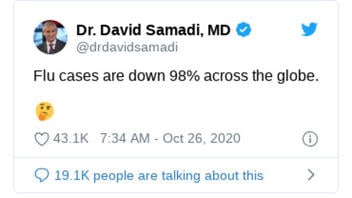STORY UPDATED: check for updates below.

Are flu cases "down 98% across the globe"? That's unclear: Lead Stories could find no evidence to support a Twitter user's un-bolstered claim that cases fell 98% worldwide. A Centers for Disease Control and Prevention (CDC) report shows a drop of 98%, but only at U.S. labs, not worldwide. A journalist who cites that figure says that she calculated that number by looking at data from Southern Hemisphere countries that have had a full flu season since the emergence of COVID-19. It's not a global statistic.
The claim appeared as a tweet (archived here) on October 26, 2020. Posted by "Dr. David Samadi, MD," it read:
Flu cases are down 98% across the globe.
This is what the post looked like on Twitter at the time of writing:
(Source: Twitter screenshot taken on Tue Oct 27 18:10:46 2020 UTC)
The post did not offer any evidence for its claim. Lead Stories reached out to Samadi to ask about his source and will update this story, as appropriate, when he responds.
Samadi's claim resembles a question posed by The Mail on Sunday's article, published October 24, 2020, entitled "Has Covid killed off the flu? Experts pose the intriguing question as influenza cases nosedive by 98% across the globe." Apart from the headline, the only other place in the story where the 98% figure was mentioned is in the context of Public Health England (PHE), a government agency. The article read:
Other research by Public Health England has confirmed this. Globally, it is estimated that rates of flu may have plunged by 98 per cent compared with the same time last year.
Lead Stories reached out to Public Health England. A spokesperson responded that the stat appears to be a misattribution, as PHE does not collect global numbers of flu cases.
Lead Stories also reached out to the author of the article to ask about her source for the figure. Journalist Jo Macfarlane responded, referencing numbers from the World Health Organization (WHO):
The 98 percent figure comes from our own calculations of WHO's FluNet surveillance data, for countries which have had a full flu season since Covid emerged.
Although it wasn't immediately clear which countries she looked at -- and for what time period -- the typical flu season in the Southern Hemisphere takes place April-September. The Northern Hemisphere is usually hit hardest October-May, while flu activity occurs throughout the year in the tropics.
In other words, the flu season in places like the United States is just getting started. Although influenza activity is currently low, it may yet be too early to make any definitive conclusions about whether cases are indeed lower than in previous years -- or by how much.
Macfarlane's 98% calculation did not include all countries. It is not a global statistic. However, she added:
The figures were put to experts in virology and epidemiology with knowledge of the 2020 flu season so far this year and all agreed this was what they had observed and was an estimate they, and others, had recognised.
Flu activity has fallen, dramatically.
Lead Stories reached out to the WHO to ask about its numbers. The agency did not comment directly on the 98% figure, but it did confirm "historic lows." Here's what the WHO said in an email:
Global influenza activity has decreased. Additional analyses are needed, but it's hypothesized that this could be due to the public health and social measures put in place for COVID-19, viral competition/interference between SARS-CoV-2 and influenza, or a combination.
The WHO said that influenza surveillance had also decreased for a number of reasons, including the fact that resources have been diverted to COVID-19 surveillance. It added:
However, despite the reduction in the number of countries sharing influenza data, we're confident in the data we have received, which has indicated influenza activity is at historic lows.
Lead Stories dug into WHO data to make our own determination. We looked at the numbers for Week 40, which includes the first week of October, generally recognized as the start of the flu season for the Northern Hemisphere. For that week, in 2019, countries reported a total number of 2,907 positive influenza viruses. During that same week this year, countries reported just 97 positive viruses, representing a percent change of close to 97%.
Other evidence flu cases may be down this year comes from a recent report from the CDC. Entitled "Decreased Influenza Activity During the COVID-19 Pandemic -- United States, Australia, Chile, and South Africa, 2020," the report looks at the relatively low rates of flu amid the global crisis. Here's what it said:
Data from clinical laboratories in the United States indicated a 61% decrease in the number of specimens submitted (from a median of 49,696 per week during September 29, 2019-February 29, 2020, to 19,537 during March 1-May 16, 2020) and a 98% decrease in influenza activity as measured by percentage of submitted specimens testing positive (from a median of 19.34% to 0.33%).
Note that the 98% number is referring to data from clinical labs in the United States. It's not a comment on global cases, although -- again -- flu activity is low worldwide.
The CDC report discusses a number of reasons why flu numbers might be lower than usual, including public health measures -- like face masks, social distancing and school closures -- that were adopted this year to stem the spread of COVID-19. Both diseases are spread primarily via droplet transmission. Here's more from the report:
The global decline in influenza virus circulation appears to be real and concurrent with the COVID-19 pandemic and its associated community mitigation measures. Influenza virus circulation continues to be monitored to determine if the low activity levels persist after community mitigation measures are eased. If extensive community mitigation measures continue throughout the fall, influenza activity in the United States might remain low and the season might be blunted or delayed.
Still, the CDC cautioned that in the midst of the uncertainty surrounding COVID-19, it's important to prepare for the upcoming U.S. flu season. It encouraged people to get flu shots. The report read:
Influenza vaccination for all persons aged ≥6 months remains the best method for influenza prevention and is especially important this season when SARS-CoV-2 and influenza virus might cocirculate.
Lead Stories reached out to the CDC for comment on this story. We will update this report, as appropriate, when it responds.
Updates:
-
2020-10-28T21:01:27Z 2020-10-28T21:01:27Z This story has been updated to add a response from journalist Jo Macfarlane and information from the World Health Organization.
















